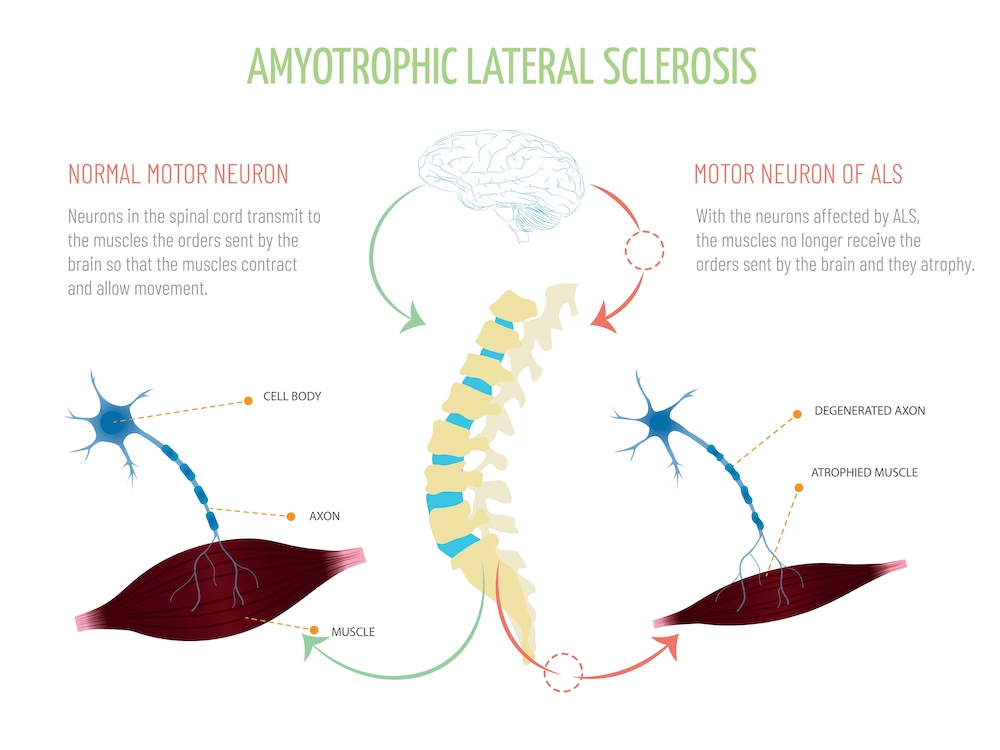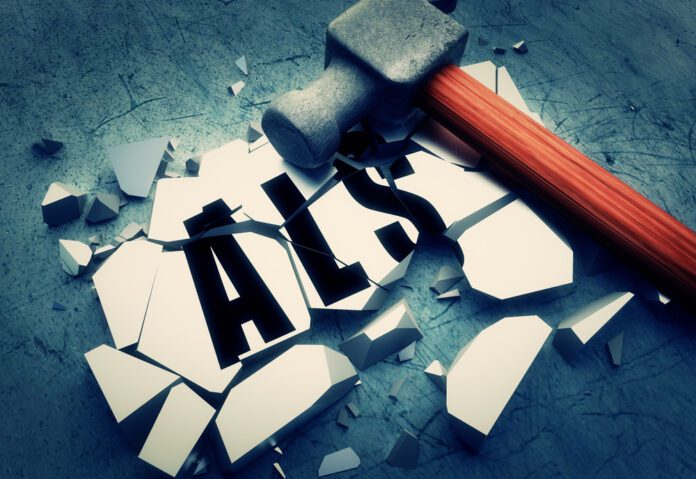What is ALS?
Amyotrophic Lateral Sclerosis (ALS), also known as Lou Gehrig’s disease, is a progressive neurodegenerative disorder that affects nerve cells in the brain and spinal cord. As the disease advances, it leads to the degeneration and death of motor neurons, which are essential for initiating and controlling muscle movement. The loss of these neurons results in increasing muscle weakness, leading to severe physical disability and, eventually, respiratory failure.
The term ‘amyotrophic’ comes from Greek, where “a” means no or negative, “myo” refers to muscle, and “trophic” means nourishment—essentially “no muscle nourishment.” “Lateral” indicates the areas in a person’s spinal cord where portions of the nerve cells that signal and control the muscles are located. As this area degenerates, it leads to scarring or hardening (“sclerosis”) in the region.
Who is Affected?
ALS affects individuals regardless of gender, race, or ethnicity, but it does have some specific patterns in terms of age, gender, and genetics:
- Age: ALS is most commonly diagnosed in people between the ages of 40 and 70, with the average age at diagnosis around 55. Although less common, the disease can also affect younger adults, sometimes even in their twenties and thirties The ALS Association and The ALS Association.
- Gender: Initially, ALS is more common in men than in women, with a reported incidence of about 20% higher in men. However, the disparity in incidence decreases with age, and by the age of 70, the rates between men and women are almost equal The ALS Association and The ALS Association.
- Genetics: About 90% to 95% of ALS cases are sporadic, meaning they occur randomly without a clear familial link. The remaining 5% to 10% of cases are familial ALS, where the disease runs in families due to genetic mutations. Some of these genetic forms of ALS present symptoms at a younger age compared to sporadic cases The ALS Association.
ALS also appears to be more common in military veterans for reasons that are not entirely understood but may involve environmental exposures or other stressors unique to military service The ALS Association.
These statistics highlight the complex nature of ALS and the importance of ongoing research to understand why certain populations are more vulnerable and how the disease can be effectively treated across different groups. For more detailed information, you can visit resources like the ALS Association’s official website: ALS Association
Symptoms of ALS

The initial symptoms of ALS can be quite subtle and include:
- Muscle weakness affecting an arm or a leg
- Slurred speech
- Trouble swallowing
- Cramping or twitching of muscles
- Impaired use of the arms and legs
As ALS progresses, individuals may experience difficulties in moving, swallowing (dysphagia), speaking or forming words (dysarthria), and breathing. Although the sequence and severity of symptoms can vary significantly from one person to another, the disease progressively reduces individuals’ abilities to walk, speak, eat, swallow, and eventually breathe.
Treatment and Management of ALS

While there is no cure for ALS and no effective treatment to halt or reverse the progression of the disease, there are treatments available that help reduce the impact of symptoms and improve the quality of life for those affected. The multidisciplinary approach to managing ALS includes the following interventions:
- Medications: Riluzole and Edaravone are two drugs approved by the FDA to slow the progression of ALS. Riluzole decreases the release of glutamate, which could help prevent nerve damage. Edaravone helps relieve oxidative stress which might improve neuronal survival.
- Therapies: Physical therapy, occupational therapy, and speech therapy can help manage symptoms and assist in maintaining independence for as long as possible.
- Nutritional Support: As swallowing becomes difficult, nutritional support and dietary adjustments are necessary.
- Respiratory Care: Various techniques and devices are available to help manage respiratory issues as the respiratory muscles get affected.
Living with ALS
Living with ALS requires adapting to new limitations as the disease progresses. Support from healthcare providers, family, friends, and ALS-specific organizations can provide the necessary help. Here are a few resources that can provide further information and support for those affected by ALS:
Comprehensive Guide to ALS Home Care Solutions: Supporting ALS Patients at Home: Practical Strategies to Enhance Quality of Life for Your Loved Ones
- Sato, Anaya G. (Author)
- English (Publication Language)
- 107 Pages – 11/08/2023 (Publication Date) – Independently published (Publisher)
Notable Figures Who Battled ALS
- Sato, Anaya G. (Author)
- English (Publication Language)
- 107 Pages – 11/08/2023 (Publication Date) – Independently published (Publisher)
Amyotrophic Lateral Sclerosis (ALS) has affected numerous notable individuals who have raised awareness about the disease through their prominence and personal stories. One of the most famous individuals with ALS was physicist Stephen Hawking, who was diagnosed at the age of 21 and went on to become one of the most renowned scientists of his time, despite the disease’s severe physical limitations. Hawking’s ability to continue his research and outreach efforts while living with ALS for over 50 years significantly changed public perceptions about the disease.
Another well-known figure is Lou Gehrig, a legendary baseball player for the New York Yankees, whose name became synonymous with the disease after his diagnosis forced an early retirement in 1939. His farewell speech, in which he described himself as “the luckiest man on the face of the earth,” remains one of the most poignant moments in sports history and brought significant attention to ALS.
Additionally, former NFL player Steve Gleason has become an influential advocate for ALS awareness since his diagnosis in 2011. His establishment of “Team Gleason,” which focuses on providing technology to help ALS patients live meaningful lives and advocating for research and awareness, has made substantial impacts in the community.
These individuals, among others, have not only faced their diagnoses with resilience and dignity but have also played crucial roles in increasing awareness, funding research, and providing resources for those affected by ALS. Their legacies continue to inspire and influence the ongoing fight against this challenging disease.

ALS Awareness Month in May is an important time to focus on understanding this debilitating disease, supporting those affected, and continuing the research necessary to find a cure. While the journey with ALS is undoubtedly challenging, advancements in medical research and the increasing availability of supportive resources offer hope and aid to those impacted.
Connect with AmeriDisability on Facebook, Twitter and Instagram.
Check out the Resources page. Claim or add your disability-focused business or nonprofit for free.







